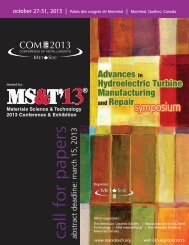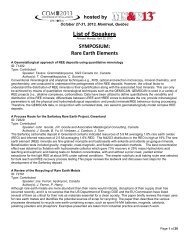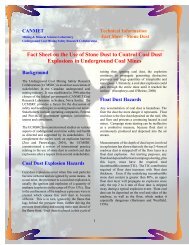List of Speakers SYMPOSIUM: Light Metals for Transportation
List of Speakers SYMPOSIUM: Light Metals for Transportation
List of Speakers SYMPOSIUM: Light Metals for Transportation
Create successful ePaper yourself
Turn your PDF publications into a flip-book with our unique Google optimized e-Paper software.
hosted byOctober 27-31, 2013, Montreal, Quebec<strong>List</strong> <strong>of</strong> <strong>Speakers</strong>Revised: Monday, April 22, 2013<strong>SYMPOSIUM</strong>:<strong>Light</strong> <strong>Metals</strong> <strong>for</strong> <strong>Transportation</strong>Effect <strong>of</strong> Iron and Sr in the evolution <strong>of</strong> Iron based intermetallic Phases in Al-Si hypoeutectic alloysID: 72811Type: ContributedSpeaker: Sumanth Shankar, McMaster University, CanadaAuthor(s): A. Gorny, J. Manickaraj, S. ShankarThe main aim <strong>of</strong> the study is to understand the <strong>for</strong>mation <strong>of</strong> the iron bearing intermetallic phases and the effect <strong>of</strong> Sraddition on them in the Al-Si hypoeutectic alloys. This study has methodically characterized the iron based intermetallicphases evolving during solidification <strong>of</strong> the Al-7 wt%Si binary alloy as a function <strong>of</strong> composition <strong>of</strong> Fe (0.1,0.2, 0.35,0.5and 0.8 wt%), Sr (0 and 200 ppm) and cooling rates (0.1, 1 and 50 K/s). The samples were analyzed by using the thermaldata obtained during solidification and various microscopy techniques. The Al-Si-Fe intermetallic phase compositionswere analyzed by Energy Dispersive X-Ray Spectrometer (EDX) and it was observed that there is anomalous evolution <strong>of</strong>certain Al-Si-Fe intermetallic phases in both alloys with and without Sr addition. The phases evolving in alloys without Sris different from that with Sr in them.Effect <strong>of</strong> Texture on Precipitation Kinetics in Aluminum AlloysID: 72373Type: ContributedSpeaker: Kaustubh Kulkarni, IIT Kanpur, IndiaAuthor(s): S. Mishra, N. Gurao, S. Shekhar, K. KulkarniControlling the orientation <strong>of</strong> precipitates can potentially improve the strength <strong>of</strong> an alloy in a desired direction.Development <strong>of</strong> texture through thermomechanical processing can affect the nucleation and growth kinetics <strong>of</strong>semicoherent precipitates that cause age hardening in aluminium alloys. In order to understand the effect <strong>of</strong> texture onage hardening kinetics, wrought aluminium alloys were thermo-mechanically processed to develop various types <strong>of</strong>textures in the alloys. The age hardening treatments are carried out on these alloys at different temperatures and times.Tensile tests were carried out on specimens drawn in different directions with respect to the rolling direction to estimatethe evolution <strong>of</strong> anisotropy in mechanical properties. A detailed analysis <strong>of</strong> microstructure as well as bulk and microtexture was carried out to establish a relationship between crystallographic texture and precipitation kinetics. This study isexpected to enable development <strong>of</strong> processing pathways <strong>for</strong> controlling the strength <strong>of</strong> age-hardened alloys in specificdirections.Elevated Temperature Wedge Compression Testing <strong>of</strong> Precipitation Hardenable Al-Sc-Zr AlloysID: 71649Type: StudentSpeaker: Cameron McNamara, Michigan Technological University, USAAuthor(s): C. McNamara, S. Kampe, P. Sanders, D. SwensonEfficient precipitation strengthening and kinetic stability can be obtained in nearly-pure aluminum through the combinedaddition <strong>of</strong> fractional percentages <strong>of</strong> scandium and zirconium. The trialuminide precipitation sequence in these alloys canbe tailored through de<strong>for</strong>mation processing and artificial aging. This work utilizes wedge-shaped compression samples <strong>of</strong>cast Al-Sc-Zr as a means to produce a continuous plastic strain gradient to examine the role <strong>of</strong> de<strong>for</strong>mation onmicrostructural evolution. The samples exhibit a radial distribution <strong>of</strong> plastic strain, and will be compressed at elevatedtemperatures to facilitate in-situ precipitation. Strengthening is quantified via microhardness mapping and microstructuralobservations; these data will be correlated with a finite element analysis (FEA) <strong>of</strong> the strain distribution. Thisexperimentation is per<strong>for</strong>med as an analog to controlled rolling, a method <strong>of</strong> reducing cost in the steel industry throughconcurrent de<strong>for</strong>mation processing and precipitation strengthening. This work is sponsored by the Office <strong>of</strong> NavalResearch, grant No. N00014-11-10876.Page 5 <strong>of</strong> 17


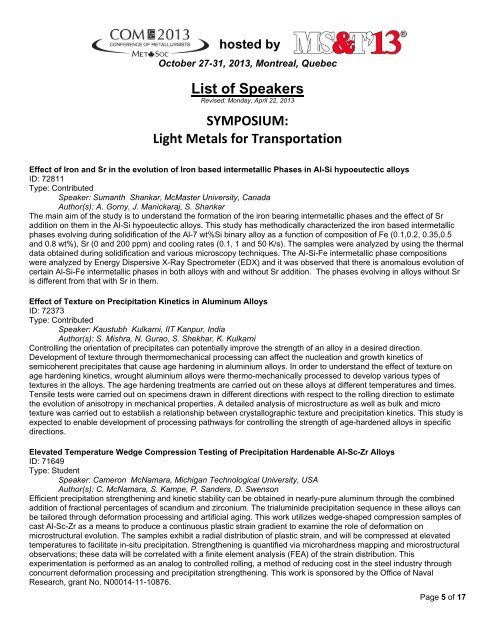

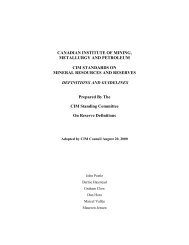
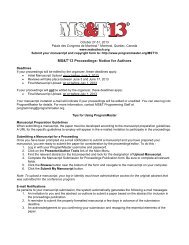


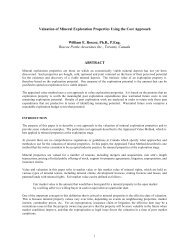
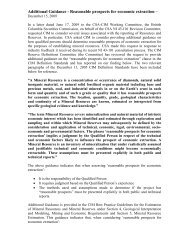
![Richard Wright - NORWEST Corporation [PDF]](https://img.yumpu.com/34320526/1/190x245/richard-wright-norwest-corporation-pdf.jpg?quality=85)
